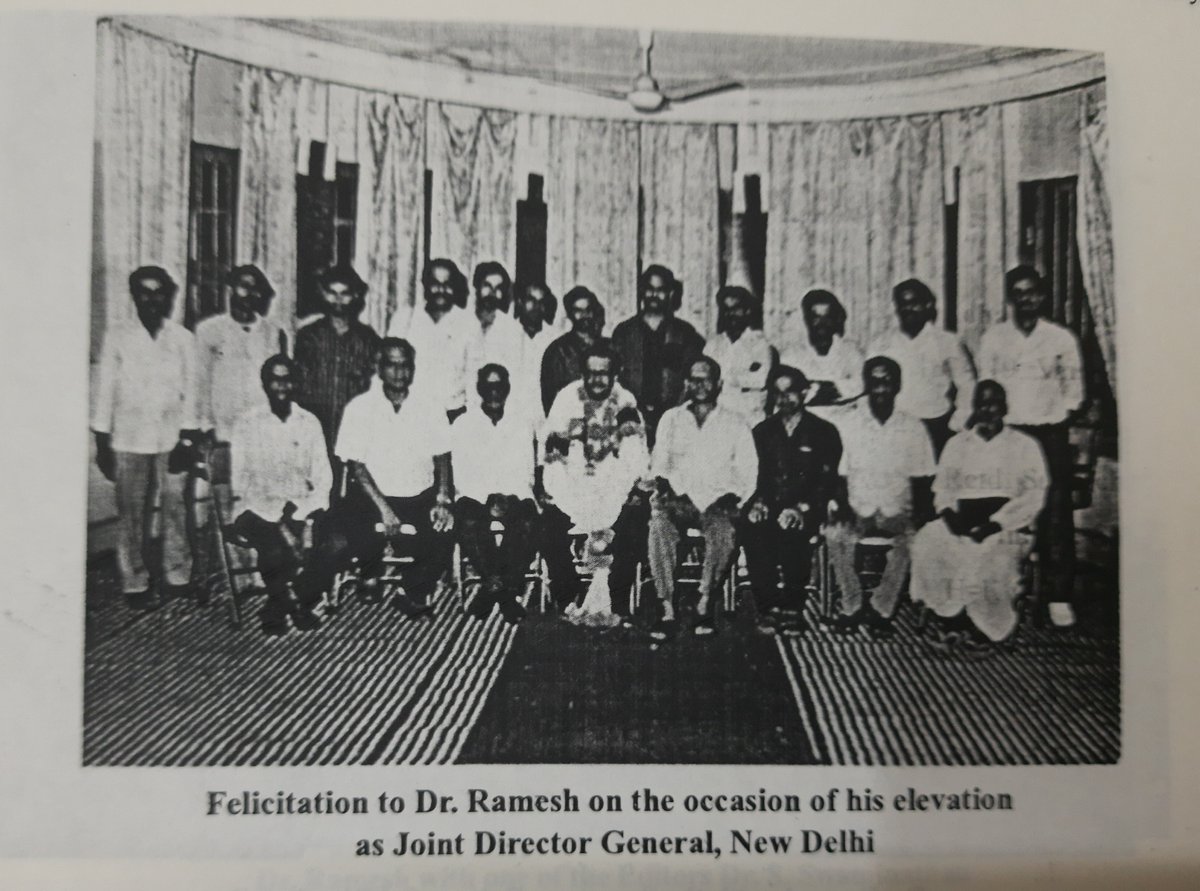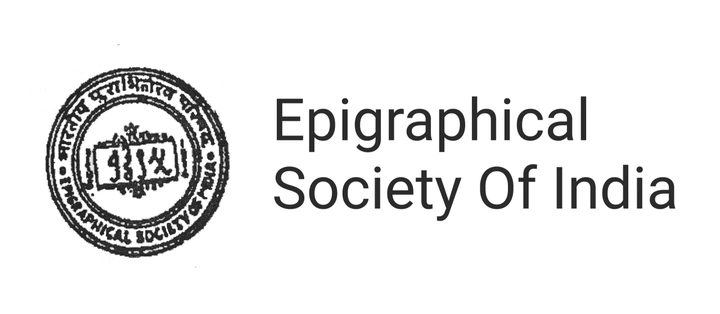
#𑀆𑀘𑀸𑀭𑁆𑀬𑀤𑁂𑀯𑁄𑀪𑀯
#ĀCĀRYADEVOBHAVA
1. In 1965, epigraphist Śri N. Lakshminārāyaṇa Rao, one of the examiners of a young Ph.D candidate, recommended that he be awarded a Ph.D, but also commented, “This candidate thinks he is infallible, like Brihaspati.”
#ĀCĀRYADEVOBHAVA
1. In 1965, epigraphist Śri N. Lakshminārāyaṇa Rao, one of the examiners of a young Ph.D candidate, recommended that he be awarded a Ph.D, but also commented, “This candidate thinks he is infallible, like Brihaspati.”
2. Little did he know that this candidate would turn out to be one of the FINEST epigraphist India had ever seen. How I wish he was alive with us today! Why is that such scholars leave this mortal world so early, creating a void which we can never fill? 

3. He is none other than the great Śri Koluvyl Vyāsrāya Śāstri Ramesh. Day before yesterday was his 87th birth anniversary. He was born on 8 June 1935 - Jyeṣṭha Śukla Saptamī, Śaka 1857, Śanivāra, at Kalpathy, Kerala to Śri Koluvyl Vyāsrāya Śāstri & Śrimati Kamalā Bāi. 

4. Koluvyl was his father's native place, a small hamlet near village Pavanje at Surathkal, Maṅgaḷūru Tāluk, Dakśiṇa Kannaḍa dist., Karnāṭaka. His father, Koluvyl Vyāsrāya Śāstri, was a Saṁskrita Paṇḍit in Victoria College at Palakkad, Kerala. Later, he was transferred to 

5. Kumbakonam, Tamil Nadu where Ramesh obtained his primary education. In 1944, his father was again transferred to Madras Presidency College. He was introduced to Kannada language by his mother Śrimati Kamalā Bāi. This constant transfer of his father made young Ramesh come into 

6. contact with different people and places and this thus helped him to become a linguist of many languages. He completed his intermediate (PUC) education from Vivekananda College at Mylapore, Chennai. Ramesh had a strong desire to enter MEDICAL PROFESSION. But destiny wished 

7. otherwise. Good for us! Or else, we would have never got such a great scholar. Ramesh joined M.A. (Saṁskrita) in Madras Presidency College in 1953 where he secured the FIRST rank and THREE GOLD medals. He passed his M.A. Examination in May 1956 and joined the Epigraphy Branch 

8. of the @ASIGoI at Ooty (renamed to its original as Udhāgamaṇdalam) on 26 June 1956 as an Epigraphical Assistant - mere two months after completing his education! He joined as a Tamil epigraphist but he established himself as a Kannada epigraphist. Climbing the ladder rung by 

9. rung, he became Deputy Superintending Epigraphist in 1966, Superintending Epigraphist in 1976, Chief Epigraphist in 1981 and in 1983, he became the first to occupy the newly created chair of the Director (Epigraphy) - topmost position of the Epigraphy branch of the ASI. 

10. And then came the fateful year 1992, when Dr. Ramesh, through sheer hard work and scholarship, crossed the boundary of epigraphy and became the Joint Director General of the @ASIGoI, next only to the topmost chair of ASI. Thus, till date, right from the establishment of the 

11. ASI in 1861 and the establishment of the Epigraphy Branch of the ASI in 1887, Dr. Ramesh is the ONLY EPIGRAPHIST to occupy the coveted position of the of the Joint DG of ASI. He retired from the ASI on 30 June 1993. From 1998 to 2006, he served as the Honorary Director of the 

12. Oriental Research Institute, University of Mysore. It was during his tenure as the Honorary Director of the Institute that it was recognized as "Manuscript Resource Centre" by the @NManuscripts. From 11 September 2012, he was appointed as the National Professor in Epigraphy 

13. by the @ASIGoI. Dr. Ramesh passed away on 10 July 2013 at the age of 78. Thus, Śri Ramesh was working for the cause of epigraphy till his last breath. His long association with the epigraphy branch made him famous as the Bhīśmācārya among the epigraphical fraternity!! 



14. As far as his contributions of Dr. Ramesh to the field of epigraphical and historical research are concerned, they are tremendous. He has published the largest number of articles in Epigraphia Indica, next only to Dinesh Chandra Sircar. The Epigraphia Indica being the touch
15. stone to test the ability of an epigraphist, Dr. Ramesh published as many as 50 articles in it! As such, he is the only epigraphist with such a long tenure in office. His doctoral thesis in Kannada titled "Tuḷunāḍina Itihāsa" which he undertook under the guidance of 

16. Dr. Giri Śridhar Dīkṣit during his tenure as Deputy Superintending Epigraphist of ASI, is a masterpiece and a source book for the study of the history of South Kanaṛa. It has even been translated into English titled "A History of South Kanaṛa: From the Earliest Times to
17. the Fall of Vijayanagara" and published in 1970. A complete index of works by Śri Ramesh can be consulted in the commemoration volume "ABHYUDAYA" dedicated to Dr. Ramesh. 



18. To accelerate epigraphical studies and studies in Place-Names, he and like minded scholars of the time established two Societies - The Epigraphical Society of India (@epigraphy_India) in 1974 at Mysuru and Place-Names Society of India (@PNSI_India) in 1977 also at Mysuru. 







19. The @epigraphy_India and the @PNSI_India have been consistently bringing out their respective journals annually since their establishment WITHOUT break - a big credit goes to Dr. Ramesh who served as the Chairman of both the societies for more than three decades! 







20. But according to me, the highlight of Dr. Ramesh's career is his historic role in the Ayodhya case which proved what Hindus were saying since more than 400 years - that a temple of Śri Rāma was demolished & the Babri Masjid was built over it. That was Dr. Ramesh being able to 



21. successfully decipher the Viṣṇu-Hari inscription which came to light as a result of the demolition of the Babri Masjid on the fateful day of 6 December 1992. the inscription was critically edited by Śri Ramesh in the Purātattva, No. 33, 2002-2003, pp. 98 - 103. 





22. This one chance discovery turned the tides of the case. The clouds over the fate of our ĀRĀDHYA were removed in 2002 itself. Unfortunately, we had to wait for another 17 years due to the antics of the 'other' parties and the judiciary. How many of us remember today the yeoman
23. service Śri Ramesh rendered to the cause of the Hindus? From today, at least remember to take his name on his birthday and offer your praṇāms to him who dedicated his life for epigraphy, history, numismatics of India. The story behind the the decipherment of Viṣṇu-Hari
24. inscription can be read here 👉 link.medium.com/5SCzTpfkKqb
Dr. Ramesh was one of those few scholars who worked on the problem of the Indus script. His approach to the decipherment of the script was refreshingly different as he tried to see Vedic connections with the script.
Dr. Ramesh was one of those few scholars who worked on the problem of the Indus script. His approach to the decipherment of the script was refreshingly different as he tried to see Vedic connections with the script.
25. Even this long thread of 25 tweets cannot do justice with the scholarship of Śri Ramesh. Taking the Epigraphical Branch of the ASI and epigraphical studies to new heights will only be a true tribute to Śri Ramesh. We owe this to Śri Ramesh.
• • •
Missing some Tweet in this thread? You can try to
force a refresh



